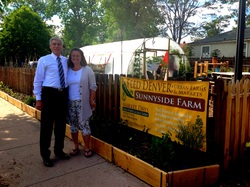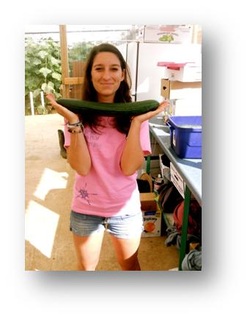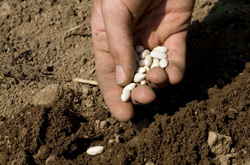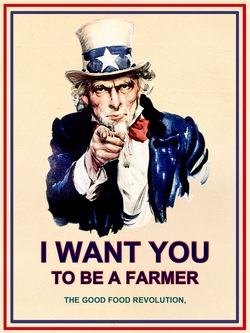 Senator Mark Udall visits Feed Denver.
Senator Mark Udall visits Feed Denver. Our neighborhood had a surprise visit from political dignitaries this week. The White House was seeking a place for Vice President Joe Biden have a conversation about immigration and they chose Common Grounds Coffeehouse (next door to our farm). He was joined by immigration community activists as well as Mayor Hancock, Senators Udall and Bennet, and Representatives DeGette and Perlmutter.
Senator Mark Udall arrived well before the rest which gave him a chance to look around. I gave him a tour of our little-urban-farm-on-a-parking lot in Sunnyside. It’s not very often that one gets the chance to spend uninterrupted time with one of the people whose decisions reach all the way back from Washington, DC to our quiet neighborhood.
As we walked among the garden starts, tasted first cherry tomatoes of the season, and tested compost temperatures we mused about the challenges of producing food in small spaces and using what you have to make a living and a difference. Our planting and composting systems may look chaotic and confusing but they rely on diversity and change. The wider the variety of companion plants, the better the protection from pests and disease. The more diverse the mix of inputs to our compost, the deeper and richer our soil.
This is also true of communities of people. The conversation inside the coffeehouse was about immigration and a lot of the conversation outside the coffeehouse, these days, is about gentrification. This community was built by immigrants and has been fertilized by a rich flow of families and cultures from around the globe. The latest converging is as challenging as change usually is but the thing is this: Is community where you came from our where you are?
Our family found their way to Sunnyside and the surrounding neighborhoods back when they were actual towns – not Denver. Near the beginning of the last century one of our grandfathers settled in Sunnyside on Raritan Street, joining the wave of late 19th century Irish immigrants drawn to Colorado for the mining. He came west for opportunity after his immigrant father fought in the Civil War.
They chose this quiet community after years in dangerous mining towns. He came to the State Capital speak up for the rights of the voiceless, and often non-English speaking, workers while leading the Colorado State Federation of Labor. He was actually a mine owner fighting for the rights of laborers. They fought for the eight hour workday in mines as well as the establishment of habeas corpus in trials. They faced violent strikes and the Ludlow massacre to move one more step to more humane conditions for workers – men, women, and children – with scant opportunity for more.
The waves of new families and cultures were just beginning at that point as he was followed by Germans and Italians seeking better opportunities. Sunnyside and the surroundings were once rich with farms feeding the Denargo Market, which was once our food packing district. In the 1960s the community was reinvigorated by new families from this continent and South America, too.
From Little Italy to The Northside, through all the trials and tribulations of mixing and melting, this community has always had a strong food culture. Where else would you go in Denver for “real” Italian or “real” Mexican food? But you know what happened? That “real” ethnic food started to change with the mix of neighbors and the availability of ingredients and tools. What we have now is North Denver Italian or Northside Mexican. And guess what? New “real” Italian and Mexican and many other ethnically identified food cultures have joined the melting pot to express their cultural inheritance.
Immigration is a tricky thing to discuss since it’s based on superficial differences and protectionist reactions. Color of skin and accent trigger assumptions. At the same time it is those unique visages and ways of life that spice up our life and communities. Whatever community you feel you are a part of, there are others to which you are an outsider, interloper, stranger.
One of the challenges of living in community is being who you are and welcoming others as they are. We struggle to build healthier families by encouraging individuality and honoring differences. This patience and joyful exploration is needed just as much to build a healthier community. It is through our differences that we weave a stronger society. And we need that strong weave of cultural partnership to face the challenges ahead and be the best that we all can be, individually and collectively.
It’s like growing food. The diversity of inputs creates healthier soil, the diversity of plants creates a community of mutual support.




 RSS Feed
RSS Feed
